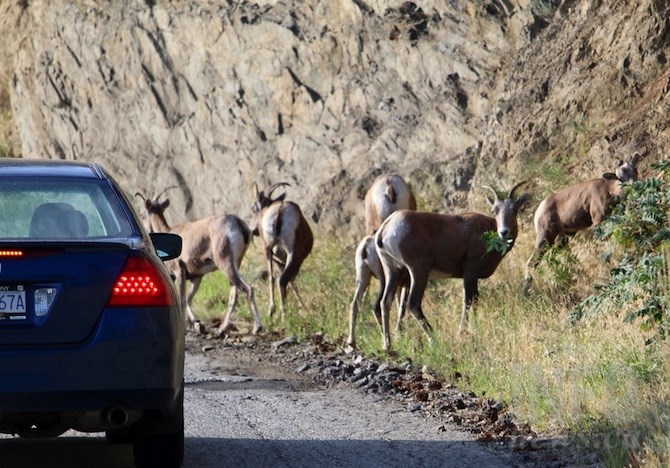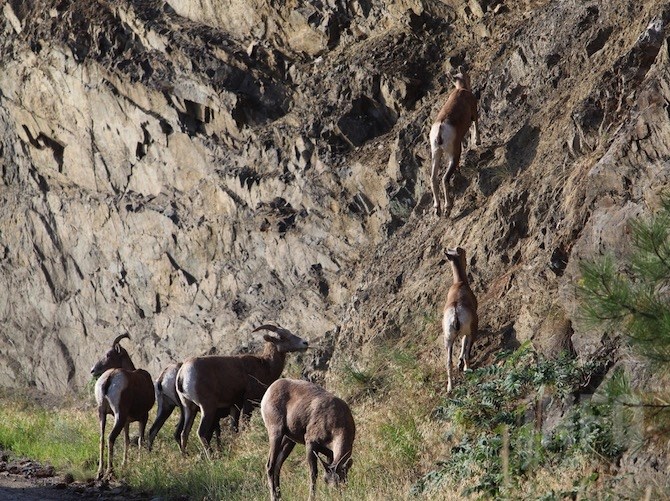
These California bighorn sheep were photographed, Thursday, Aug. 22, 2019, on Westside Road near Kelowna but are found throughout the Thompson and Okanagan regions.
(ROB MUNRO / iNFOnews.ca)
August 28, 2019 - 6:00 AM
KELOWNA - More than a decade of wildfires have devastated wide swaths of Interior forests and contributed to sawmill shutdowns but for the resident California bighorn sheep, those fires are good news.
“The 2003 Okanagan Mountain Park is a prime example of a habitat that is, now, probably what it should look like,” Chris Barker, past-president and current projects chair for the Wild Sheep Society of B.C. told iNFOnews.ca. “We allowed all that timber to grow in the park. That land base basically got revitalized to historic grassland with mixed timber growth (after the fire). It opened up the sightlines and opened up some visibility and gave those sheep the ability to spot their predators.”
In the 1980s, logging companies stopped doing slash burns in harvested areas, allowing the forests to grow unnaturally thick. Not only does that provide fuel for fires, but it also leaves sheep open to attack from predators.
About five years after the Okanagan Mountain Park fire, 56 sheep were transplanted into the park in three different groups. Two were taken from near Keremeos and one from the Kamloops area. There are now about 100 sheep in the park – enough for a limited hunt of about three a year.

These California bighorn sheep liked the area near the warning sign on Westside Road near Kelowna between Traders Cove and Lake Okanagan Resort.
(ROB MUNRO / iNFOnews.ca)
Another transplant from Kamloops to the Shorts Creek area on the west side of Okanagan Lake had a different outcome and shows the impact of predation on the sheep. In that case, the 13 tagged sheep were all dead within two years.
“Once you get a female cougar that kills sheep, she trains her kittens to kill sheep,” Barker said. “It can have a pretty devastating impact on a sheep population. They (sheep) will usually herd up with between 15 to 20 animals. She (cougar) can take out a herd within a year.”
The Westside herd ranges between Shorts and Bear Creeks. They used to range further south to near the Okanagan Connector but there has been too much human intrusion, Barker said.

Vehicles don't seem to disturb these California bighorn sheep along Westside Road near Kelowna.
(ROB MUNRO / iNFOnews.ca)
Not that the sheep along Westside Road between Traders Cover and Okanagan Lake Resort had any fear of cars. In one case, the sheep were right beside a sheep crossing sign and cars slowed down or stopped, although anyone speeding south over the blind hill would have risked plowing into them.
“If we get them to come up off the road, that’s going to be the magic thing,” Barker said. He heard of one sheep killed by a car last year but no reports so far this year.
Barker is trying to get projects organized throughout the region to have fire breaks created to not only protect communities but to open up corridors for sheep. He would prefer for those to be controlled burns, similar to what First Nations people used to do, but it’s a hard sell.

Some of the bighorn sheep along Westside Road near Kelowna sort of did what they are expected to do, and started climbing a cliff.
(ROB MUNRO / iNFOnews.ca)
To contact a reporter for this story, email Rob Munro or call 250-808-0143 or email the editor. You can also submit photos, videos or news tips to the newsroom and be entered to win a monthly prize draw.
We welcome your comments and opinions on our stories but play nice. We won't censor or delete comments unless they contain off-topic statements or links, unnecessary vulgarity, false facts, spam or obviously fake profiles. If you have any concerns about what you see in comments, email the editor in the link above.
News from © iNFOnews, 2019